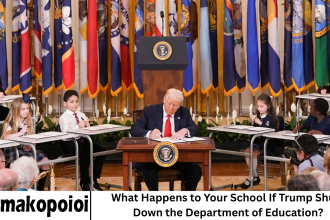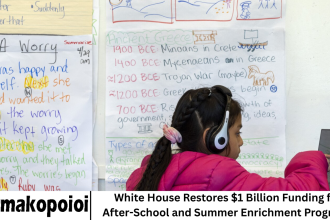Few government agencies stir as much political passion as the U.S. Department of Education (ED). Since its creation in 1979 under President Jimmy Carter, the department has been both a symbol of federal commitment to equal educational opportunity and a lightning rod for critics who argue that education should be left to states and local communities.
- The Origins of the U.S. Department of Education
- The Department’s Current Role and Responsibilities
- Distributing Federal Funding
- Enforcing Civil Rights
- Managing Student Aid
- Research and Policy Guidance
- Accountability and Oversight
- Why Trump Wants to Shut It Down
- What Would Happen If the Department Were Eliminated?
- Student Aid Chaos
- Civil Rights Enforcement Gap
- Disruption in Federal Funding
- Data and Research Loss
- Political Fallout
- Historical Efforts to Abolish the Department
- The Department’s Defenders: Why It Matters
- The Financial Footprint: What’s at Stake
- The Political Landscape: Can It Actually Happen?
- The Future of U.S. Education Policy
- Frequently Asked Question
- Conclusion
Now, former President Donald Trump has reignited the decades-old debate by proposing to shut down the Department of Education entirely if he returns to the White House. His plan reflects a growing conservative push to shrink federal authority and empower local school systems.
But such a move would have enormous consequences for America’s 50 million public school students, thousands of universities, and trillions of dollars in student loans and grants.
This article explores what the Department of Education actually does, how it’s funded, what Trump’s arguments are, and what could happen if the department were eliminated.
The Origins of the U.S. Department of Education
The Department of Education (ED) was established in 1979 when President Jimmy Carter signed the Department of Education Organization Act, separating education functions from the Department of Health, Education, and Welfare.
The goal was to create a focused federal body dedicated to promoting educational excellence and ensuring equal access to schooling across the nation.
Before ED existed, education policy was largely fragmented among various agencies. The new department aimed to:
- Streamline federal education programs
- Gather data and research to inform policy
- Enforce federal laws against discrimination in education
- Provide student financial aid through grants and loans
When it opened its doors in May 1980, the department had about 4,400 employees and a budget of $12 billion. Today, those numbers have grown exponentially — a point of contention for critics like Trump.
The Department’s Current Role and Responsibilities
The U.S. Department of Education does not run schools or dictate curricula — those responsibilities remain primarily with states and local districts. Instead, its core functions include:
Distributing Federal Funding
ED manages billions in federal funds that support K–12 schools, especially those serving low-income students, through programs like:
- Title I Grants (for disadvantaged schools)
- Individuals with Disabilities Education Act (IDEA) (for special education)
- Pell Grants and federal student loans (for higher education)
In fiscal year 2024, the department’s discretionary budget was approximately $79.6 billion, making it one of the smaller cabinet-level agencies — yet one with significant influence.
Enforcing Civil Rights
The Office for Civil Rights (OCR) within the department ensures that schools and universities receiving federal funds comply with laws against discrimination based on race, sex, disability, or national origin.
Managing Student Aid
The Office of Federal Student Aid (FSA) handles over $1.6 trillion in student loans and disburses grants and work-study funds to more than 10 million students annually.
Research and Policy Guidance
Through the National Center for Education Statistics (NCES) and Institute of Education Sciences (IES), the department conducts studies that shape policy decisions nationwide.
Accountability and Oversight
It ensures states meet federal education standards under laws like the Every Student Succeeds Act (ESSA), enacted in 2015 to replace the controversial No Child Left Behind Act.
Why Trump Wants to Shut It Down
Former President Trump has long criticized the Department of Education, describing it as “bloated, wasteful, and intrusive.” His 2024 campaign platform proposes eliminating the department altogether and transferring most of its responsibilities to states.
Here’s what underpins his argument:
Federal Overreach
Trump and many conservatives believe the federal government should have no role in local schooling decisions, such as curriculum, testing, or gender and race policies. They see the Department of Education as a symbol of federal interference in what should be local matters.
Bureaucratic Inefficiency
Critics argue the department consumes billions in administrative costs while producing little measurable improvement in student outcomes. They point to stagnant national test scores and growing debt burdens as evidence of failure.
Cultural and Ideological Concerns
In recent years, debates over critical race theory, gender identity policies, and school choice have intensified. Trump and his allies frame the department as a hub of liberal ideology, accusing it of promoting “woke” agendas in schools.
State Empowerment
Under Trump’s vision, education funding and oversight would return to states and local governments, allowing more tailored approaches to local needs — and aligning with the Republican philosophy of smaller federal government.
What Would Happen If the Department Were Eliminated?
Shutting down the Department of Education is easier said than done. Doing so would require an act of Congress, and the consequences would be enormous.
Student Aid Chaos
Without the Department, the federal student loan system — which serves over 40 million borrowers — would need to be entirely restructured. It’s unclear whether states could absorb that responsibility.
Civil Rights Enforcement Gap
The elimination of the Office for Civil Rights would weaken federal oversight of discrimination in schools. Students facing racial, sexual, or disability-based bias might lose a key channel for justice.
Disruption in Federal Funding
Billions in Title I and IDEA funds would be in limbo. States might receive “block grants,” but redistribution could vary widely, potentially deepening inequality between wealthy and poor districts.
Data and Research Loss
Without federal data collection, nationwide benchmarks for performance and progress could disappear, making it harder to compare schools across states.
Political Fallout
Dismantling an entire cabinet department would be a political and logistical nightmare, drawing opposition from teachers’ unions, higher education groups, and civil rights organizations.
Even some conservatives warn that abrupt abolition could backfire by creating confusion and harming the very students Republicans claim to champion.
Historical Efforts to Abolish the Department
Trump’s idea isn’t new. Several Republican leaders before him have tried — and failed — to dismantle the Department of Education.
- Ronald Reagan (1981): Promised to abolish it, but faced resistance from Congress and ultimately backed down.
- Newt Gingrich (1994): The “Contract with America” proposed merging the department into a larger agency.
- Rick Perry (2011): As a presidential candidate, Perry famously couldn’t remember the department’s name when listing agencies he’d cut — but it was on his list.
- Donald Trump (2016–2024): Revived the call, arguing that education decisions belong entirely to parents and local officials.
Despite decades of attempts, the department has survived — often strengthened by the very debates surrounding its existence.
The Department’s Defenders: Why It Matters
Supporters of the Department of Education argue that abolishing it would harm vulnerable students and undermine national progress toward equality and innovation.
Equal Opportunity
Federal involvement helps ensure that all students — regardless of race, income, or disability — have access to quality education. Programs like Title I and IDEA exist because state funding alone often falls short.
National Standards and Research
Without federal data collection and policy guidance, America’s fragmented education system would struggle to track progress or set consistent standards.
Economic Impact
Education is a major driver of economic competitiveness. Federal investments in higher education, vocational training, and research help prepare the workforce for global competition.
Accountability
The department ensures taxpayer dollars are spent effectively and that schools meet minimum performance and equity standards.
For many educators, the department is less about bureaucracy and more about protecting fairness and opportunity.
The Financial Footprint: What’s at Stake
Let’s put the scale of ED’s operations in perspective:
- $1.6 trillion in outstanding student loans
- 10 million students receiving Pell Grants
- $18 billion annually in Title I funds
- $15 billion for special education
- 4,000+ employees nationwide
Eliminating the department would require redistributing these responsibilities to other agencies or the states — an administrative puzzle that could take years and billions of dollars to unwind.
Moreover, education is deeply intertwined with the U.S. economy. Federal aid supports college attendance, teacher training, and job readiness programs. Cutting that pipeline could have ripple effects across labor markets.
The Political Landscape: Can It Actually Happen?
Even if Trump wins another term, abolishing the Department of Education would require:
- Congressional approval (including Senate support)
- Major legislative restructuring of existing education laws
- Reallocation of federal funds and personnel
Given the complexity and resistance such a move would face, experts say it’s unlikely to happen wholesale. Instead, Trump could attempt to drastically shrink the department — slashing budgets, consolidating programs, or delegating powers to states.
This “de facto abolition” could reduce the department’s reach without formally closing it.
The Future of U.S. Education Policy
Regardless of what happens politically, Trump’s proposal has reignited a broader debate:
What role should the federal government play in education?
Some see federal oversight as essential to equity and accountability. Others view it as a barrier to innovation and local control.
Future education policy — under Trump or any successor — will likely revolve around these themes:
- School choice and vouchers
- Parental rights in curriculum decisions
- Student loan reform
- Teacher shortages and pay
- Equity in public education
As America’s education system faces new challenges — from AI in classrooms to declining college enrollment — the conversation over federal versus local power will only grow louder.
Frequently Asked Question
What does the U.S. Department of Education actually do?
The department oversees federal funding for K–12 and higher education, manages student loans and grants, enforces civil rights in schools, and collects data to inform education policy.
How large is the Department of Education’s budget?
For fiscal year 2024, its budget is about $79.6 billion, funding programs like Pell Grants, Title I aid for low-income schools, and special education.
How many people work at the Department of Education?
The department employs around 3,800–4,000 staff members, making it relatively small compared to other federal agencies.
Why does Trump want to shut down the department?
Trump argues that the department represents federal overreach, wastes taxpayer money, and promotes liberal ideologies. He believes education should be governed at the state and local levels.
Could the department actually be abolished?
It’s possible but extremely difficult. Eliminating a cabinet department requires an act of Congress, major restructuring of education laws, and alternative systems for managing student aid and civil rights enforcement.
What would happen to student loans if the department were shut down?
The federal student loan system, currently managed by the Department of Education, would need to be transferred to another agency or privatized — a massive and complex task that could affect millions of borrowers.
How would closing the department affect students and teachers?
It could lead to funding instability, especially for low-income districts and special education programs. Many fear it would widen inequality and reduce federal protections for students’ rights.
Conclusion
The push to abolish the Department of Education sits at the crossroads of philosophy, policy, and politics. To Trump and his allies, it represents a return to local freedom and smaller government. To others, it threatens decades of progress toward fairness and access.
While the future of the department remains uncertain, one fact is clear: education is too vital to become collateral damage in political battles. The debate may shift forms, but the question endures — how much federal involvement is too much, and how little is too little?






















